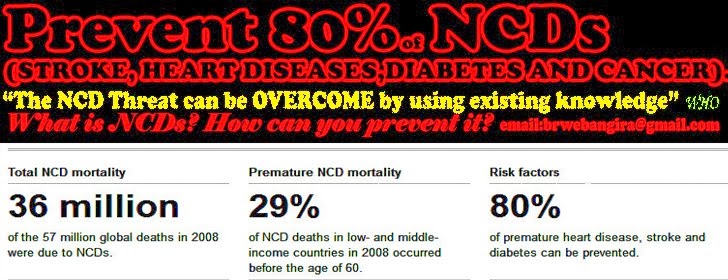“Non-communicable diseases (NCDs), such as heart disease, stroke,
cancer, chronic respiratory diseases and diabetes, are the leading cause of
mortality in the world.”
Of the 57 million global deaths in
2008, that is 36 million, or 63%, were due to non-communicable diseases, very
unfortunate that 29% of these premature deaths occurred in the low and middle
income countries before the age of 60.
But WHO says that, “eighty percent of premature heart
diseases, stroke, and diabetes can be prevented.”
This invisible epidemic is an under-appreciated cause of
poverty and hinders the economic development of many countries, Tanzania
included. The burden is growing - the number of people, families, companies and
communities afflicted is increasing.
Let’s look at fact sheet for each NCDs:-
DIABETES
v
347 million people worldwide have diabetes1.
v
In 2004, an estimated 3.4 million people died
from consequences of high blood sugar.
v
More than 80% of diabetes deaths occur in low-
and middle-income countries.
v
WHO projects that diabetes deaths will increase
by two thirds between 2008 and 2030
v
The burden of diabetes is increasing globally,
particularly in developing countries
CANCER.
v
Cancer is
a leading cause of death worldwide, accounting for 7.6 million deaths (around
13% of all deaths) in 2008 (1).
v
Lung,
stomach, liver, colon and breast cancer cause the most cancer deaths each year.
v
About 30%
of cancer deaths are due to the five leading behavioral and dietary risks: high
body mass index, low fruit and vegetable intake, lack of physical activity,
tobacco use, alcohol use.
v
Cancer
causing viral infections such as HBV/HCV and HPV are responsible for up to 20%
of cancer deaths in low- and middle-income countries.
v
About 70% of all cancer deaths in 2008 occurred
in low- and middle-income countries.
v
Deaths
from cancer worldwide are projected to continue rising, with an estimated 13.1
million deaths in 2030
Cardiovascular diseases
(CVDs)
v
CVDs are the number one cause of death globally:
more people die annually from CVDs than from any other cause.
v
An estimated 17.3 million people died from CVDs
in 2008, representing 30% of all global deaths. Of these deaths, an estimated
7.3 million were due to coronary heart disease and 6.2 million were due to
stroke.
v
Low- and middle-income countries are
disproportionally affected: over 80% of CVD deaths take place in low- and
middle-income countries and occur almost equally in men and women.
v
By 2030, almost 25 million people will die from
CVDs, mainly from heart disease and stroke. These are projected to remain the
single leading cause of death.
v
Most cardiovascular diseases can be prevented by
addressing risk factors such as tobacco use, unhealthy diet and obesity,
physical inactivity, raised blood pressure, diabetes and raised lipids.
v
7.5 million Deaths each year, or 13% of all
deaths can be attributed to raised blood pressure. This includes 51% of deaths
due to strokes and 45% of deaths due to coronary heart disease.
v
In 2008, diabetes directly contributed to 1.3
million deaths.
OBESITY/ OVERWEIGHT
v
Worldwide obesity has more than doubled since
1980.
v
In 2008, more than 1.4 billion adults, 20 and
older, were overweight. Of these over 200 million men and nearly 300 million
women were obese.
v
65% of the world's populations live in countries
where overweight and obesity kills more people than underweight.
v
More than 40 million children under the age of
five were overweight in 2010.
v
Obesity is preventable.
World Health Organization says, “The NCD threat can be overcome
using existing knowledge.”
As legend Greek dramatist, Menander (342–291 BC) said,
“Health and intellect are the
two blessings of life.”
Edmark International through its Edmark Education System is providing thus SPECIAL KNOWLEDGE for FREE on how to overcome this epidemic, we believe
together WE CAN. No entrance fee, but its better you book your space earlier to avoid inconveniences. Call: 0784475576
















